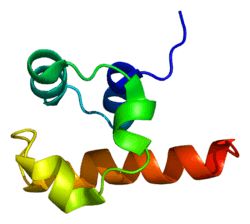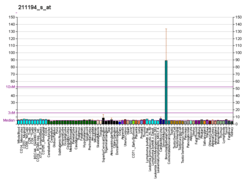TP63
Tumor protein p63 also known as transformation-related protein 63 is a protein that in humans is encoded by the TP63 gene.[5][6][7][8]
TP63 also known as the p63 gene was discovered 20 years after the discovery of the p53 tumor suppressor gene and along with p73 constitutes the p53 gene family based on their structural similarity.[9] Despite being discovered significantly later than p53, phylogenetic analysis of p53, p63 and p73, suggest that p63 was the original member of the family from which p53 and p73 evolved.[10]
Function
Tumor protein p63 is a member of the p53 family of transcription factors. p63 -/- mice have several developmental defects which include the lack of limbs and other tissues, such as teeth and mammary glands, which develop as a result of interactions between mesenchyme and epithelium. TP63 encodes for two main isoforms by alternative promoters (TAp63 and ΔNp63). ΔNp63 is involved in multiple functions during skin development and in adult stem/progenitor cell regulation.[11] In contrast, TAp63 has been mostly restricted to its apoptotic function and more recently as the guardian of oocyte integrity.[12] Recently, two new functions have been attributed to TAp63 in heart development[13] and premature aging.[14]
Clinical significance
TP63 mutations underlie several malformation syndromes that include cleft lip and/or palate as a hallmark feature.[15] Mutations in the TP63 gene are associated with ectrodactyly-ectodermal dysplasia-cleft syndrome in which a midline cleft lip is a common feature,[15] cleft lip/palate syndrome 3 (EEC3); ectrodactyly (also known as split-hand/foot malformation 4 (SHFM4)); ankyloblepharon-ectodermal dysplasia-cleft lip/palate (AEC) or Hay–Wells syndrome in which a midline cleft lip is also a common feature,[15] Acro–dermato–ungual–lacrimal–tooth syndrome (ADULT); limb-mammary syndrome; Rap-Hodgkin syndrome (RHS); and orofacial cleft 8. Both cleft lip with or without a cleft palate and cleft palate only features have been seen to segregate within the same family with a TP63 mutation.[15] Recently, induced pluripotent stem cells have be produced from patients affected by EEC syndromes by cell reprogramming. The defective epithelial commitment could be partially rescued by a small therapeutic compound.[16]
Diagnostic utility
p63 immunostaining has utility for head and neck squamous cell carcinomas, differentiating prostatic adenocarcinoma (the most common type of prostate cancer) and benign prostatic tissue;[17] normal prostatic glands stain with p63 (as they have basal cells), while the malignant glands in prostatic adenocarcinoma (which lacks these cells) do not.[18] P63 is also helpful in distinguishing poorly differentiated squamous cell carcinoma from small cell carcinoma or adenocarcinoma. P63 should be strongly stained in poorly differentiated squamous cell, but negative in small cell or adenocarcinoma.[19]
Interactions
TP63 has been shown to interact with HNRPAB.[20] It also activates IRF6 transcription through the IRF6 enhancer element.[15]
Regulation
There is some evidence that the expression of p63 is regulated by the microRNA miR-203.[21][22]
See also
- AMACR - another marker for prostate adenocarcinoma
Further reading
External links
- GeneReviews/NCBI/NIH/UW entry on Ankyloblepharon-Ectodermal Defects-Cleft Lip/Palate Syndrome or AEC Syndrome, Hay-Wells Syndrome. Includes: Rapp-Hodgkin Syndrome
- OMIM entries on AEC
- 1 2 3 GRCh38: Ensembl release 89: ENSG00000073282 - Ensembl, May 2017
- 1 2 3 GRCm38: Ensembl release 89: ENSMUSG00000022510 - Ensembl, May 2017
- ↑ "Human PubMed Reference:".
- ↑ "Mouse PubMed Reference:".
- ↑ Yang A, Kaghad M, Wang Y, Gillett E, Fleming MD, Dötsch V, Andrews NC, Caput D, McKeon F (Sep 1998). "p63, a p53 homolog at 3q27-29, encodes multiple products with transactivating, death-inducing, and dominant-negative activities". Molecular Cell. 2 (3): 305–16. PMID 9774969. doi:10.1016/S1097-2765(00)80275-0.
- ↑ Osada M, Ohba M, Kawahara C, Ishioka C, Kanamaru R, Katoh I, Ikawa Y, Nimura Y, Nakagawara A, Obinata M, Ikawa S (Jul 1998). "Cloning and functional analysis of human p51, which structurally and functionally resembles p53". Nature Medicine. 4 (7): 839–43. PMID 9662378. doi:10.1038/nm0798-839.
- ↑ Zeng X, Zhu Y, Lu H (Feb 2001). "NBP is the p53 homolog p63". Carcinogenesis. 22 (2): 215–9. PMID 11181441. doi:10.1093/carcin/22.2.215.
- ↑ Tan M, Bian J, Guan K, Sun Y (Feb 2001). "p53CP is p51/p63, the third member of the p53 gene family: partial purification and characterization". Carcinogenesis. 22 (2): 295–300. PMID 11181451. doi:10.1093/carcin/22.2.295.
- ↑ Wu G, Nomoto S, Hoque MO, Dracheva T, Osada M, Lee CC, Dong SM, Guo Z, Benoit N, Cohen Y, Rechthand P, Califano J, Moon CS, Ratovitski E, Jen J, Sidransky D, Trink B (May 2003). "DeltaNp63alpha and TAp63alpha regulate transcription of genes with distinct biological functions in cancer and development". Cancer Research. 63 (10): 2351–7. PMID 12750249.
- ↑ Skipper M (January 2007). "Dedicated protection for the female germline". Nature Reviews Molecular Cell Biology. 8 (1): 4–5. doi:10.1038/nrm2091.
- ↑ Crum CP, McKeon FD (2010). "p63 in epithelial survival, germ cell surveillance, and neoplasia". Annual Review of Pathology. 5: 349–71. PMID 20078223. doi:10.1146/annurev-pathol-121808-102117.
- ↑ Deutsch GB, Zielonka EM, Coutandin D, Weber TA, Schäfer B, Hannewald J, Luh LM, Durst FG, Ibrahim M, Hoffmann J, Niesen FH, Sentürk A, Kunkel H, Brutschy B, Schleiff E, Knapp S, Acker-Palmer A, Grez M, McKeon F, Dötsch V (Feb 2011). "DNA damage in oocytes induces a switch of the quality control factor TAp63α from dimer to tetramer". Cell. 144 (4): 566–76. PMC 3087504
 . PMID 21335238. doi:10.1016/j.cell.2011.01.013.
. PMID 21335238. doi:10.1016/j.cell.2011.01.013. - ↑ Rouleau M, Medawar A, Hamon L, Shivtiel S, Wolchinsky Z, Zhou H, De Rosa L, Candi E, de la Forest Divonne S, Mikkola ML, van Bokhoven H, Missero C, Melino G, Pucéat M, Aberdam D (Nov 2011). "TAp63 is important for cardiac differentiation of embryonic stem cells and heart development". Stem Cells. 29 (11): 1672–83. PMID 21898690. doi:10.1002/stem.723.
- ↑ Su X, Paris M, Gi YJ, Tsai KY, Cho MS, Lin YL, Biernaskie JA, Sinha S, Prives C, Pevny LH, Miller FD, Flores ER (Jul 2009). "TAp63 prevents premature aging by promoting adult stem cell maintenance". Cell Stem Cell. 5 (1): 64–75. PMC 3418222
 . PMID 19570515. doi:10.1016/j.stem.2009.04.003.
. PMID 19570515. doi:10.1016/j.stem.2009.04.003. - 1 2 3 4 5 Dixon MJ, Marazita ML, Beaty TH, Murray JC (Mar 2011). "Cleft lip and palate: understanding genetic and environmental influences". Nature Reviews Genetics. 12 (3): 167–78. PMC 3086810
 . PMID 21331089. doi:10.1038/nrg2933.
. PMID 21331089. doi:10.1038/nrg2933. - ↑ Shalom Feuerstein R. et al. Impaired epithelial differentiation of induced pluripotent stem cells from EEC patients is rescued by APR-246/PRIMA-1MET. P.N.A.S 2012. http://minus.com/lbmC3TVGDx350s
- ↑
- ↑
- ↑
- ↑
- ↑
- ↑







